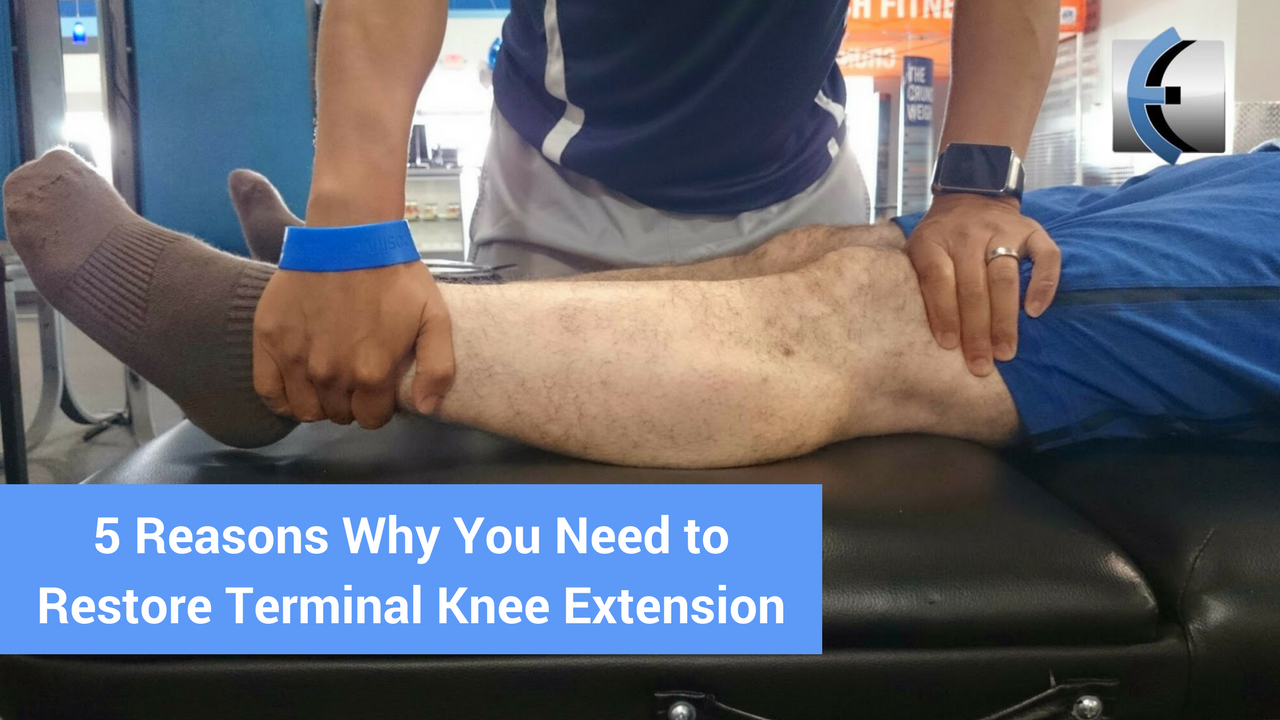Restoring full terminal knee extension (TKE) should be a top priority if your patients are lacking it. Functioning/playing without full knee extension motion can cause problems not only at the knee joint but also up & down the kinetic chain.
Here's what one study said:
- "Loss of full knee extension is a potentially debilitating problem. It is thought that a lack of symmetrical knee extension after ACL reconstruction is more debilitating than preoperative instability and that a small loss of extension is particularly detrimental for the active population." (1)
And just so we’re all clear, stopping at 0° is not restoring full TKE. Measure the other knee (as long as that side
isn’t dysfunctional/pathological) and that is what your goal should be. Most people have about 5° of hyperextension (6° in female and 5° in male high school athletes [2]), but it may be more or less so, again, measure the uninvolved knee.
Check out this video on a quick and easy way to assess knee
extension ROM – it’s how I do it unofficially and then I follow up with an
actual goniometer measurement…and yes, I still actually use a goniometer.
The Easiest Knee Assessment in the World via MMT Resources
The Easiest Knee Assessment in the World via MMT Resources
So why is it so important to restore terminal knee extension
for your patients?
Lacking full terminal knee extension:
- Leads to worse patient outcomes
- this study "showed that the most statistically significant factor related to lower subjective scores was lack of normal knee extension" - and they considered normal knee ROM to be within 2° of extension, including hyperextension (3)
- Increases the risk for developing arthritis
- multiple studies have shown that people with limited knee extension have a higher prevalence of arthritis (even in is little as a 3° loss) - here are what a couple of them said/found:
- "less than normal knee extension ROM at discharge was a predictive factor for developing OA after ACL surgery" (4)
- "loss of normal knee ROM at final follow-up was associated with a higher prevalence of OA" (5)
- Causes an abnormal gait
- this should be rather obvious - if you're lacking extension motion, you can't achieve TKE during terminal stance...which puts more strain/stress on other structures in the kinetic chain
- this slightly flexed position causes abnormal joint loading too
- Beats up the patella tendon
- If someone's knee never gets fully straight (and into the closed-pack position) and is always slightly flexed, then it will put more strain & constant stress on the patella tendon
- Limits the ability of the quad and other muscles to optimally function/produce force
- a lack of full knee extension will impair the quad's ability to generate force, leading to reduced knee extension torque (3)
- and maybe this weakness isn't directly because of limited knee ext, rather it could be because of pain, irritated patella tendon, OA, etc. But regardless, the evidence is still there that there is a correlation between limited knee extension and quad weakness
- limited knee extension will also affect other joints, most notably the ankle and hip. Think about the triple extension required in most athletic activities - if the knee can't fully extend, then the ankle and hip have to overcompensate and will have a hard time generating the appropriate force - leading to decreased performance and possible injury.
So make sure you assess (remember 0° is not normal or enough for most people) and, if needed, correct a loss of knee extension motion because it can greatly improve your patient outcomes!
And if you're looking for a simple, effective, and affordable tool to help your patients get back their extension, then the "Knee Terminator" is right up your alley:
Dr. Dennis Treubig, DPT
1. Noll S, Garrison JC, Bothwell J, Conway JE. Knee extension ROM at 4 weeks is related to knee extension loss at 12 weeks after ACL reconstruction. Ortho J Sports Med. 2015;3:2325967115583632
2. Decarlo MS, Sell KE. Normative data for range of motion and single-leg hop in high school athletes. J Sport Rehabilitation. 1997;6:246-255
3. Shelbourn KD, Gray T. Minimum 10-year results after ACL reconstruction - how the loss of normal knee motion compounds other factors related to the development of osteoarthritis after surgery. Am J Sports Med. 2017;3:471-480
4. Shelbourne KD, Benner RW, Gray T. Results of ACL reconstruction with patellar tendon autografts: objective factors associated with the development of osteoarthritis at 20 to 33 years after surgery. Am J Sports Med. 2017 Aug 1:363546517718827
5. Shelbourne KD, Urch SE, Gray T, Freeman H. Loss of normal knee motion after ACL reconstruction is associated with radiographic arthritic changes after surgery. Am J Sports Med. 2012 Jan;40(2):108-113
Want an approach that enhances your existing evaluation and treatment? No commercial model gives you THE answer. You need an approach that blends the modern with the old school. Live cases, webinars, lectures, Q&A, hundreds of techniques and more! Check out Modern Manual Therapy!
Keeping it Eclectic...






![[RESEARCH] Risk of Running Injuries](https://blogger.googleusercontent.com/img/a/AVvXsEjKvyGevVSrJIhjR-mGB7KhM0Mj8hW-kUoNmwH-svioGQZ_KWGkXgF4qHDIFM4hTk87rg_-Js6ArRHw181ToN_ukQh45u5Wqa6YhaPLfYjwcYMdqWvY6xHPx1BVPGPhQ1AVQnbGMtUYCeg87fBShJ3Ci0kBmlOo-sqRqvsyozIVG2tMt9N6qRGiz_aW=s72-c)









Post a Comment
Post a Comment